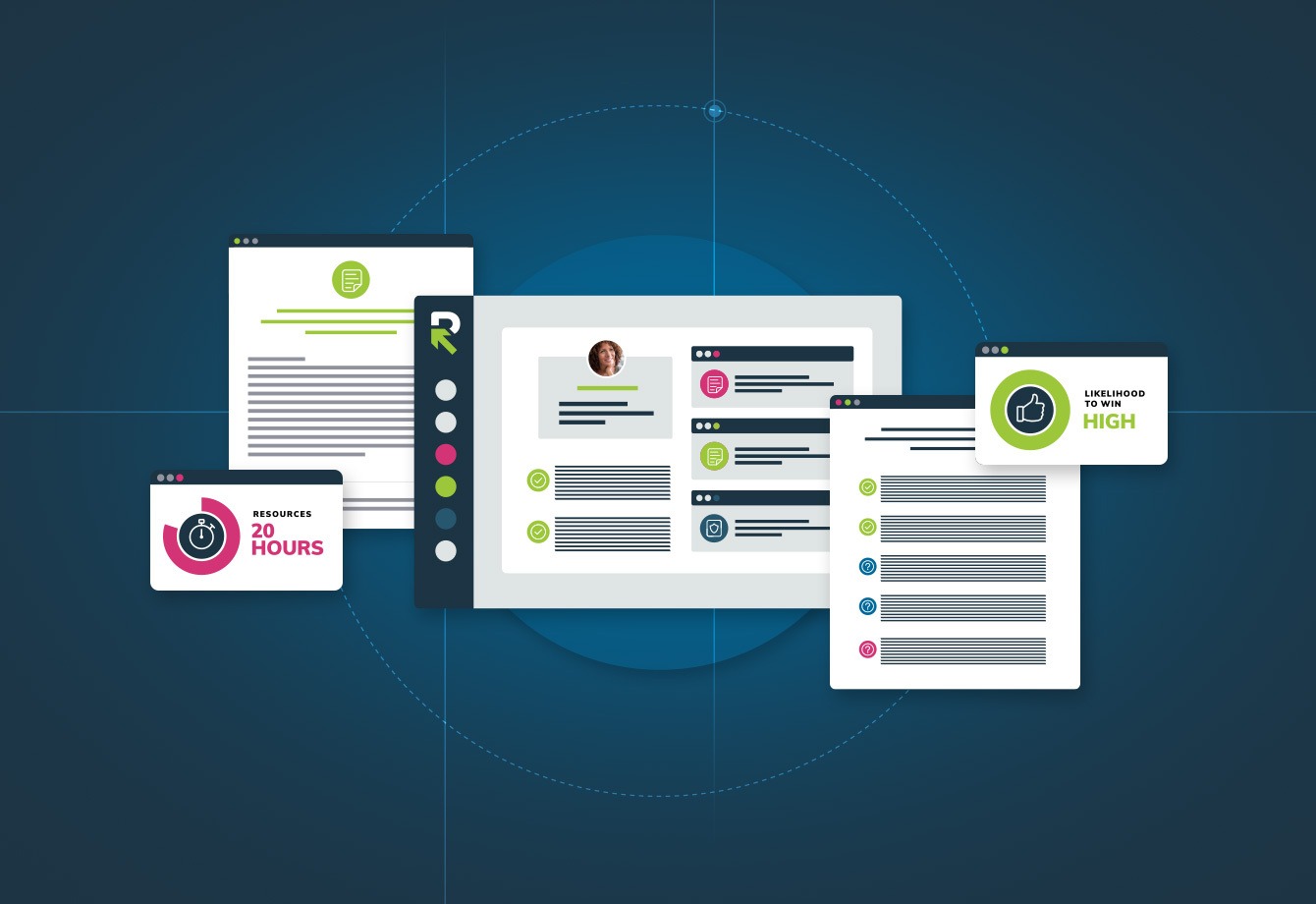RFP stands for request for proposal, but it’s so much more than that. It’s a plea for help, a clue to problems that need solved, and an opportunity to build pipeline. This article will take you from asking, “What is an RFP?” to knowing how to use RFPs to drive revenue in less than 1,500 words. Buckle up.
First, an assumption: If you came here because you want to know what an RFP is, then I’m guessing that a high-value target has decided to issue an RFP to find a solution to a problem you feel strongly about solving. When that target finally understands that you’re the answer to their problem, then you’ll pick up a sizable chunk of business. Now you just have to play the RFP game.
(Just in case you’re here because you want to know how to issue an RFP, check out this article instead.)
What is an RFP opportunity?
There are essentially two types of RFP opportunities: solicited and unsolicited. Solicited means that you’re invited to play the game. Unsolicited means you have to crash the game. You have a better chance to win when you’re invited.
That reminds me. There’s a fair bit of jargon in the RFP world. Here’s a short glossary of some common terms you’ll encounter often, including in this article:
- RFP issuer: The organization that sends out the RFP. They have a problem, and they’re willing to pay someone to solve it, within certain parameters.
- RFP responder: You.
- RFP response: How you answer the RFP.
- RFP proposal: Your response to the RFP.
- RFP Q&As: Most RFPs present a number of questions that responders must answer. This section makes up the lion’s share of your proposal.
- RFP win: You were selected by the issuer to solve their problem.
- RFP loss: Happens to the best of us.
Back to more on “What is an RFP opportunity?”…While you can still win an RFP if you submit an unsolicited response, the odds are against you and you need to take an honest look at whether or not it’s worth it to respond.
RFP responses are not easy, even when you’re invited to partake. If you’re lucky enough to be alerted to an RFP on the day it’s issued, then you’re likely looking at a 3-6 week window to compose your response. Rarely are you so lucky. Sometimes it’s brought in with notice of a week or less, putting you on a tight deadline. The number of hours you’ll have to commit to building a proposal during that time will be determined by, among other things, team participation, content relevance and access, and how much you have to rely on manual processes to complete the response.
Now that you understand what an RFP is and the opportunity it presents, you need to put yourself on a path to respond only to those RFPs that you can realistically win. If this is one of your first RFP responses, then it could be a rabbit hole of unknown depths. Insert a go/no-go milestone before you go ask Alice. It involves asking yourself the following five questions:
- What was your level of involvement prior to the RFP being issued?
- Is your solution a fit (now, not at some squishy date in the future after you’ve had a chance to adapt it to what the problem calls for)?
- Does your price match the RFP issuer’s budget?
- Will winning the RFP be a strategic fit for your organization?
- Do you have bandwidth (to complete a competitive proposal, not to deliver your solution)?
As part of the RFP response process, you should have an opportunity to ask the questions necessary to fill in the gaps for your go/no-go milestone. Best-case scenario? Your sales team has already laid the groundwork for all of this with the issuer and it’s just a matter of taking their learnings and making them actionable.
It’s a “go.” Now what?
It’s a process deal. Doesn’t that take the pressure off?
I won’t get into the nitty gritty of the RFP process here (you can do so here if you’re ready to start now), but I will touch on the value of efficiency. Even if this is your first RFP, you’ll want to go into it as prepared as possible to save you and your team some pain and give your organization its best shot at winning.
Break down your efficiency goals into three main categories: project management, content management, and proposal quality. Before you start checking boxes under these categories, you need a team. Part of that team has likely already formed. The salesperson at the tip of the spear will be your subject matter expert (SME) for issuer-related questions and perspectives. The rest of the team will come together based on your review of the RFP. What questions need answered? Who has the answers? Who has the design and technical chops to build the proposal?
After you identify potential team members, dig into their availability and try to build a schedule to complete the response by deadline, preferably before deadline to give yourself some buffer. Then schedule a kickoff meeting with all team members to get their buy-in to process details for the following:
- Project management: You’ll be the lead for collaboration, assigning tasks, and driving the schedule.
- Content management: You’ll need content creators, content reviewers, and a storage system for a content library (if you’re gathering all this valuable info for an RFP, you’ll want to save it for repurposing; even if this will be your only RFP response of the year, the info will be useful for business proposals, answering prospect and customer questions, and training new hires).
- Proposal quality: Answering RFP Q&As won’t be enough. You need to personalize the proposal to make it stand out.
Remember, the issuer is using the RFP process to identify its optimal vendor. They’re inciting competition, so you need to play to win. Second prize doesn’t even get a set of steak knives.
Beef up your sales pipeline
Now that you’ve discovered RFPs and the opportunities they can offer, you may want to evaluate how they can help you achieve your sales goals. 69% of B2B salespeople do not have enough leads in their pipeline to meet quota. Pursuing RFPs can build up pipelines fast: Globally, $11 trillion of revenue is won through competitive proposal processes (i.e., RFPs) every year.
Obviously, you’re not going to win every RFP. We found the average win rate to be 45%. However, RFP opportunities can cost as much as 5X more than traditional sales opportunities, which makes your process and your sales tech stack your best friends when it comes to response efficiency.
Automate to dominate
The optimized sales technology stack is a hot point of conversation these days. With so many RFP automation software solutions, it’s easy for sales teams to overspend on solutions they barely use. A recent Harvard Business Review article cites a survey where 62% of B2B companies were not satisfied with their sales technology return on investment. It also found that:
“The winning companies in our analysis were 1.4 times more likely to fully deploy sales technology tools and 1.9 times more likely to fully integrate them…By taking the time to embed these technologies properly into its sales processes, the [SaaS] company was able to increase revenue growth by 200 basis points within a few weeks.”
RFP automation offers a massive competitive advantage for responders. It saves time, improves proposal quality, and helps companies create their best work by activating their company knowledge. Companies with RFP-specific technology responded to 43% more RFPs in 2020 than those without a designated RFP tool. “With RFPIO, I would say we have increased our win rate by 15%,” said Grégory Saive, IBA global director of sales support and tender management,
But it has to be the right RFP software for your sales tech stack. It has to be able to manage your entire response process — from building proactive proposals to answering prospect and customer questions on the fly and responding to questionnaires — while integrating seamlessly with the other applications you rely on, such as your CRM, communication, and cloud storage solutions.
What’s next? Demo.
We started with “What is an RFP?” and made it all the way through to the value of RFP automation. Once you win one, you’re going to want to win more. Since I’m almost at my promised 1,500-word cap, I’ll wrap it up with a tip on your next step: Schedule a demo. It’s the fastest and easiest way to find out if RFP automation is right for you. Even if it’s not, you’ll get some valuable response tips from our process experts.



